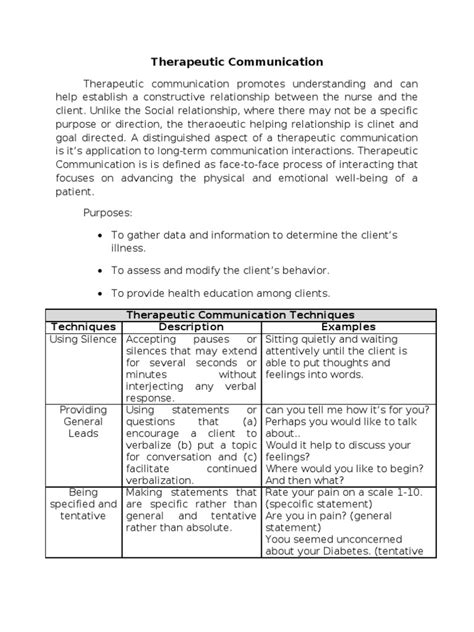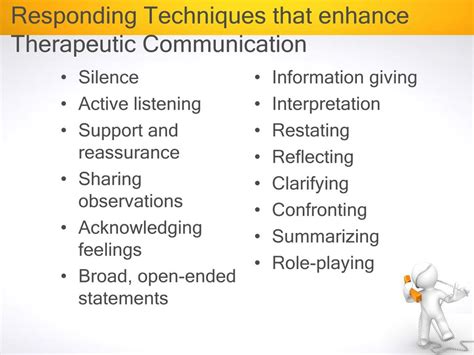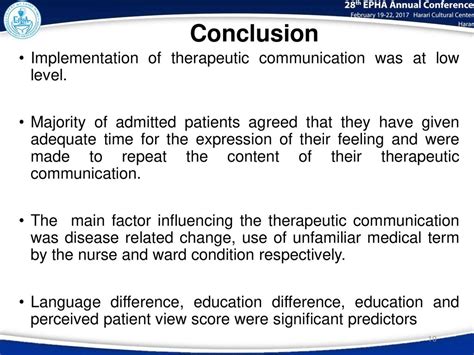Intro
Master the art of therapeutic communication with our comprehensive guide. Learn effective patient interaction techniques, active listening skills, and empathetic responses to build trust and rapport. Discover how to navigate challenging conversations, manage conflicts, and promote positive patient outcomes. Boost your nursing skills with our expert advice on therapeutic communication.
The ability to communicate effectively with patients is a crucial aspect of healthcare. Therapeutic communication is a vital skill for healthcare professionals to master, as it enables them to build trust, establish rapport, and provide high-quality care. In this article, we will delve into the world of therapeutic communication, exploring its importance, key principles, and practical strategies for effective patient interaction.
Therapeutic communication is a complex process that involves more than just exchanging information between healthcare professionals and patients. It requires empathy, active listening, and a deep understanding of the patient's physical, emotional, and psychological needs. By mastering therapeutic communication skills, healthcare professionals can improve patient outcomes, enhance patient satisfaction, and reduce medical errors.
Effective therapeutic communication is essential in healthcare settings, where patients may be anxious, fearful, or uncertain about their diagnosis, treatment, or prognosis. When healthcare professionals communicate effectively, patients feel heard, validated, and empowered to take an active role in their care. This, in turn, can lead to improved adherence to treatment plans, better health outcomes, and enhanced patient satisfaction.

Key Principles of Therapeutic Communication
Therapeutic communication is built on several key principles, including:
Empathy
Empathy is the ability to understand and share the feelings of another person. Healthcare professionals can demonstrate empathy by actively listening to patients, acknowledging their concerns, and showing compassion.
Active Listening
Active listening involves fully engaging with the patient, maintaining eye contact, and avoiding interruptions. Healthcare professionals should focus on the patient's words, tone, and body language to ensure they understand the patient's concerns.
Non-Judgmental Attitude
A non-judgmental attitude is essential in therapeutic communication. Healthcare professionals should avoid making assumptions or jumping to conclusions about the patient's condition or behavior.
Open-Ended Questions
Open-ended questions encourage patients to share their thoughts, feelings, and concerns. Healthcare professionals should use open-ended questions to gather information, rather than relying on closed-ended questions that may limit the patient's response.
Reflection and Clarification
Reflection and clarification involve rephrasing and restating the patient's words to ensure understanding. This technique helps to build trust and ensures that the healthcare professional has accurately understood the patient's concerns.
Benefits of Therapeutic Communication
Therapeutic communication offers numerous benefits for patients, healthcare professionals, and healthcare organizations. Some of the benefits include:
- Improved patient satisfaction and outcomes
- Enhanced patient engagement and empowerment
- Reduced medical errors and adverse events
- Improved communication between healthcare professionals and patients
- Increased patient trust and loyalty

Strategies for Effective Therapeutic Communication
Several strategies can enhance therapeutic communication, including:
Use of Simple Language
Healthcare professionals should use simple, clear language to communicate with patients. Avoiding technical jargon and complex medical terminology can help to reduce confusion and anxiety.
Cultural Sensitivity
Cultural sensitivity is essential in therapeutic communication. Healthcare professionals should be aware of cultural differences and adapt their communication style to meet the patient's needs.
Non-Verbal Communication
Non-verbal communication, such as body language and facial expressions, can convey empathy and understanding. Healthcare professionals should be aware of their non-verbal cues and use them to build rapport with patients.
Active Engagement
Active engagement involves actively listening to patients, asking open-ended questions, and encouraging patients to share their concerns. This technique can help to build trust and establish a therapeutic relationship.
Challenges in Therapeutic Communication
Therapeutic communication can be challenging, particularly in situations where patients may be anxious, fearful, or uncertain. Some of the challenges include:
- Language barriers
- Cultural differences
- Power imbalances
- Emotional distress

Overcoming Barriers in Therapeutic Communication
Several strategies can help to overcome barriers in therapeutic communication, including:
Use of Interpreters
Interpreters can help to overcome language barriers and facilitate communication between healthcare professionals and patients.
Cultural Competence Training
Cultural competence training can help healthcare professionals to understand cultural differences and adapt their communication style to meet the patient's needs.
Emotional Support
Emotional support can help patients to manage anxiety, fear, and uncertainty. Healthcare professionals should offer emotional support and empathy to patients, particularly in situations where patients may be experiencing distress.
Technology-Enabled Communication
Technology-enabled communication, such as telemedicine and patient portals, can facilitate communication between healthcare professionals and patients. This can be particularly useful in situations where patients may be geographically isolated or have mobility issues.
Conclusion
Therapeutic communication is a vital skill for healthcare professionals to master. By understanding the key principles, benefits, and strategies for effective therapeutic communication, healthcare professionals can improve patient outcomes, enhance patient satisfaction, and reduce medical errors. While challenges may arise, several strategies can help to overcome barriers and facilitate effective communication.

We invite you to share your thoughts and experiences with therapeutic communication. How do you think healthcare professionals can improve their communication skills? What strategies have you found to be effective in your own practice? Share your comments below, and let's continue the conversation.
What is therapeutic communication?
+Therapeutic communication is a type of communication that involves empathy, active listening, and a deep understanding of the patient's physical, emotional, and psychological needs.
Why is therapeutic communication important in healthcare?
+Therapeutic communication is essential in healthcare as it enables healthcare professionals to build trust, establish rapport, and provide high-quality care. It can also improve patient outcomes, enhance patient satisfaction, and reduce medical errors.
What are some strategies for effective therapeutic communication?
+Some strategies for effective therapeutic communication include using simple language, being culturally sensitive, using non-verbal communication, and actively engaging with patients.
